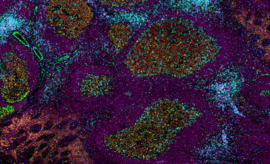MicroRNA-21 Deficiency Alters the Survival of Ly-6C lo Monocytes in ApoE −/− Mice and Reduces Early-Stage Atherosclerosis—Brief Report
Objective—
To determine the role of microRNA-21 (miR-21) on the homeostasis of monocyte subsets and on atherosclerosis development in
ApoE
−/−
(apolipoprotein E) mice.
Approach and Results—
In
ApoE
−/−
mice, miR-21 expression was increased in circulating Ly-6C
lo
nonclassical monocytes in comparison to Ly-6C
hi
monocytes. The absence of miR-21 significantly altered the survival and number of circulating Ly-6C
lo
nonclassical monocytes in
ApoE
−/−
mice. In the early stages of atherosclerosis, the absence of miR-21 limited lesion development both in the aortic sinus (by almost 30%) and in the aorta (by almost 50%). This was associated with less monocyte availability in circulation and increased apoptosis of local macrophages in plaques. At later stages of atherosclerosis, lesion size in the aortic root was similar in
ApoE
−/−
and
ApoE
−/−
miR-21
−/−
mice, but plaques showed a less stable phenotype (larger necrotic cores) in the latter. The loss of protection in advanced stages was most likely because of excessive inflammatory apoptosis related to an impairment of local efficient efferocytosis.
Conclusions—
Gene deletion of miR-21 in
ApoE
−/−
mice alters Ly-6C
lo
nonclassical monocytes homeostasis and contribute to limit early-stage atherosclerosis.


